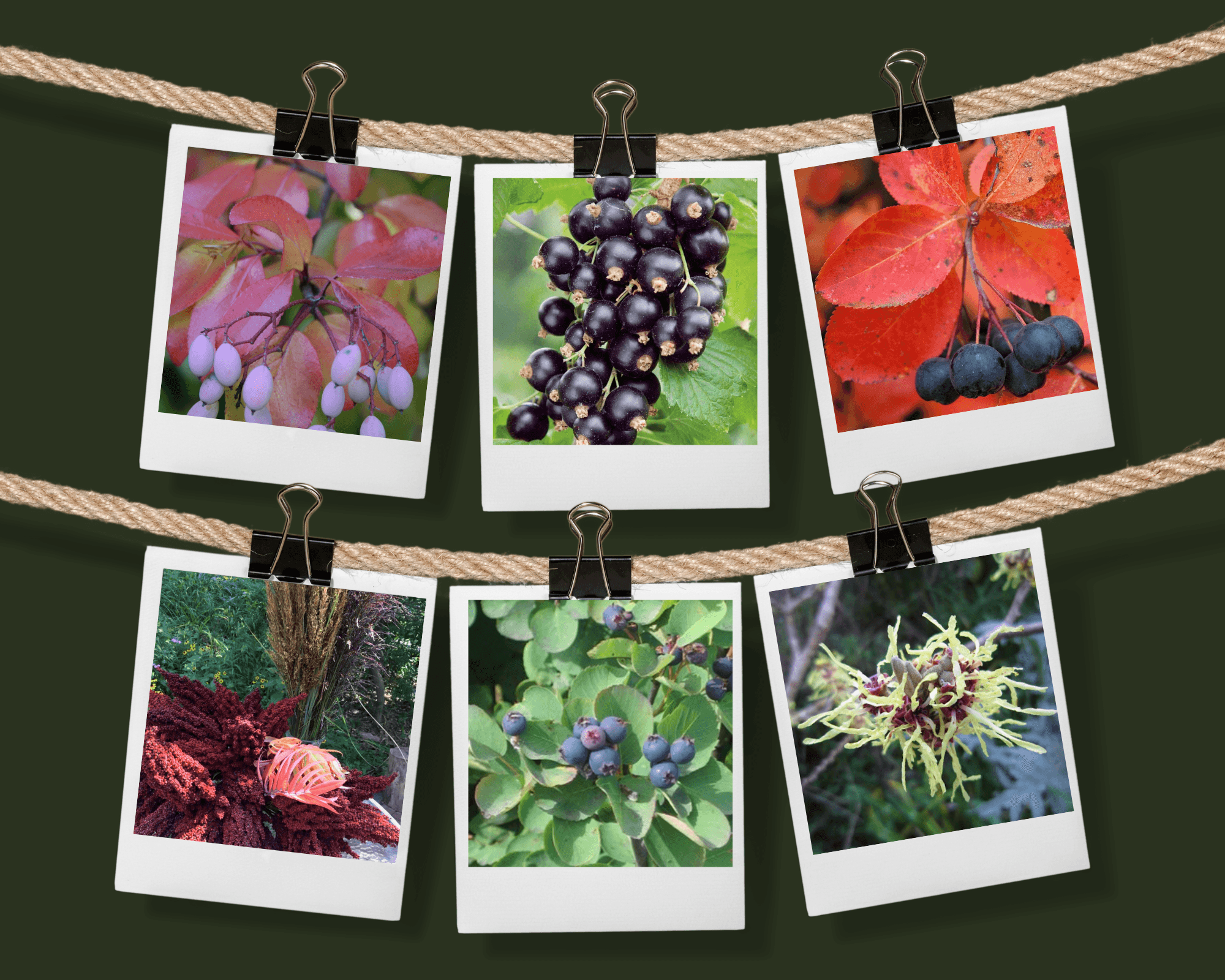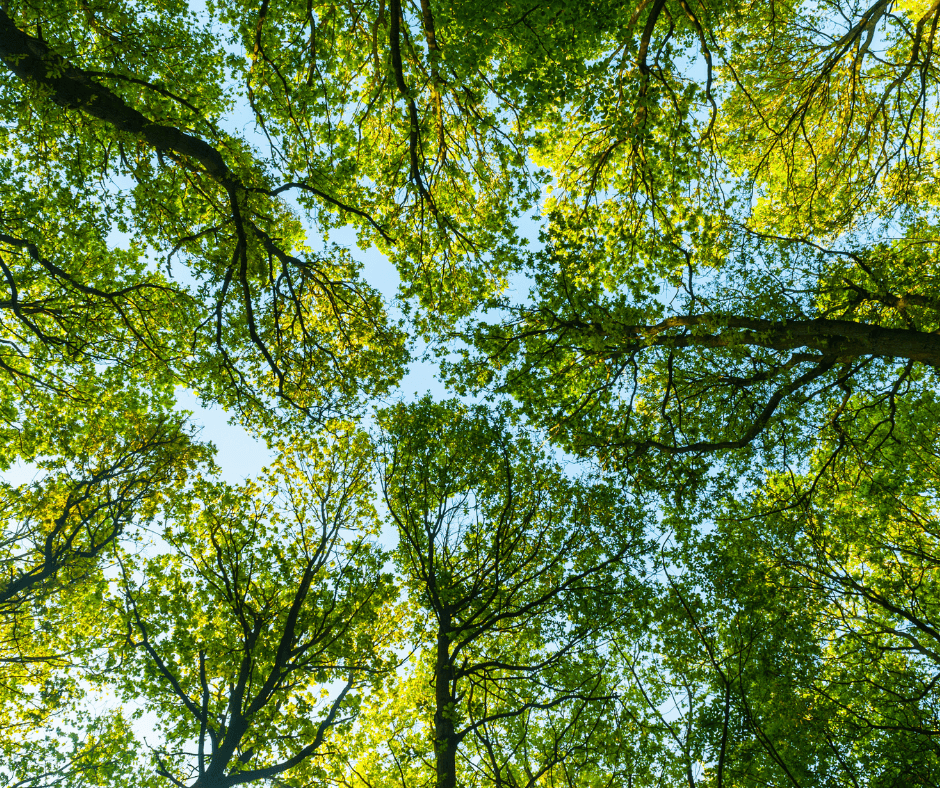
Top row, from left to right: blackhaw viburnum, black currant and black chokeberry; bottom row, from left to right: staghorn sumac, western serviceberry and witch hazel.
May is Nebraska Bird Month, which makes it the perfect time to highlight a handful of shrubs that birds (and other wildlife) love. Here are six native shrubs that benefit birds, mammals and pollinators.
Black chokeberry (Aronia melanocarpa)
This small, multi-stemmed deciduous shrub (3-6 feet tall), thrives in part shade, with moist, acidic (<6.8 pH) soils. It's also flood tolerant. Black chokeberry blooms in May with clusters of six white flowers on its branches. Its dark green, finely toothed foliage turns brilliant red in autumn, alongside the dark blue berries it produces (prolific berry production occurs under full sun conditions).
Black chokeberry flowers are beneficial to pollinator species in the Lepidoptera (butterflies and moths) family, and the berries appeal to all sorts of wildlife, including most bird species and small mammals. The northern cardinal in particular loves black chokeberry berries; in general, birds prefer the black chokeberries over the red variety.
One thing to note about black chokeberry is that it suckers freely, so it requires proper pruning to ensure it does not overtake your landscape.
Black currant (Ribes nigrum)
A small, deciduous, fruit-producing shrub, R. nigrum thrives in organically rich, medium moisture soils. This shrub grows up to five feet tall, with a three-to-five-foot spread, and it prefers full sun (but it can tolerate part shade too).
Be patient with black currant, as it can take up to five years to reach fruit production. It's well worth the wait, however, especially for the birds, who love black currant berries and appreciate the shrub's long fruiting season. We humans can eat black currant berries too. They are high in vitamin C and antioxidants, including anthocyanins, which give black currants their characteristic dark color and fight free radicals in the body. The small white flowers of R. nigrum bloom in May and are beneficial to pollinators, particularly bumble bees and sweat bees.
A few challenges to be aware of before you plant black currant: it is susceptible to powdery mildew in wet, humid conditions; aphids are known to like this species, and it is an alternate host for white pine blister rust. It also needs to be protected from strong winter winds and frost pockets. Additional tips: add compost to the root zone regularly; avoid top watering; and give this shrub uniformly moist soil.
Blackhaw viburnum (Viburnum prunifolium)
This medium to tall (12-20 feet) multi-stemmed deciduous shrub is best grown in dry to medium, well-drained soils. It can survive in a variety of locations from full sun to shade; however it does best in part shade and is well-suited for borders as a tall hedge.
This shrub offers three seasons of visual interest. In the spring, its large white blooms (up to 4.5 inches in diameter) give way to purplish berry-like drupes in autumn. These drupes are an important source of food for wildlife because they are known to persist well into the winter, giving birds and mammals an option for winter foraging. Bright red foliage in the fall also adds to the Blackhaw viburnum's appeal.
Staghorn sumac (Rhus typhina)
An easily grown, deciduous shrub that prefers dry to average moisture in part-shade to full sun, staghorn sumac spreads in the wild to create thickets through root suckering and self-seeding and is tolerant of numerous soil types, with the exception of poorly drained, waterlogged soils.
Staghorn sumac is particularly recognizable during the winter, when its thick, pointed branches resemble antlers (which is how it gets its common name). The branches also have a velvety, fuzzy feel to them, which distinguishes them from other sumac.
This shrub can grow 15-25 feet tall, and the dense thickets of sumac colonies make them perfect for nesting habitat for birds and mammals, as well as for bees, which are known to pick sumac for their overwintering spot.
Large, odd-pinnate leaves are bright green during the summer, with a brilliant fall color. Eventually by late summer/early fall, the female sumac produces pyramid-shaped fruit clusters called drupes that can be up to 10 inches long. This fruit is grazed by wildlife, particularly in the winter when other fruit is hard to find.
Unless you have a lot of space, staghorn sumac probably would not be the best choice for a yard shrub. It's ideal for hard-to-cover, dry areas of land where it can be allowed to form colonies.
Western serviceberry (Amelanchier alnifolia)
Growing to a height of 6-18 feet, with a 4-8 foot spread, this small deciduous tree or shrub typically has a single trunk structure, thrives in part shade to sun and prefers moist, well-drained soil (but is drought tolerant). Its white blooms are small but are especially important for native bees.
While serviceberry is an important wildlife food for birds -- especially American goldfinch, tufted titmice, brown thrashers, blue jays, Carolina chickadees, northern cardinals and American robins -- and ungulates (hooved mammals) year round, it is typically grazed in the spring. Because the twigs and leaves contain cyanide compounds, it's best for humans to consume the berries only, which can be made into jelly and as filling for pies and cobblers.
The serviceberry is easily propagated in the early spring from hardwood cuttings or from softwood cuttings in the summer. A light pruning is needed to reduce suckering throughout the growing season.
Witch hazel (Hamamelis virginiana)
Common witch hazel is a medium-sized, deciduous shrub (15-20 foot height/spread) that thrives in part shade, preferring medium moisture and organically rich soil. Birds love its fruit and its dense, thicket-like nature for habitat, while butterflies and moths enjoy witch hazel flowers, which bloom in the fall and are quite aromatic.
Historically, First Nations peoples used witch hazel leaves for tea to treat sore throats, colds and coughs, as well as a topical treatment for rashes and other skin ailments.
Click HERE to download a list of other Nebraska trees and shrubs that support wildlife.

